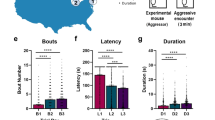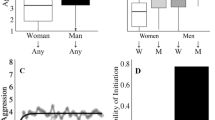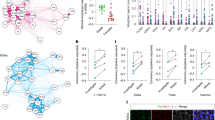Abstract
Aggression is an evolutionarily conserved, adaptive component of social behavior. Studies in male mice illustrate that aggression is influenced by numerous factors including the degree to which an individual finds aggression rewarding and will work for access to attack and subordinate mice. While such studies have expanded our understanding of the molecular and circuit mechanisms of male aggression very little is known about female aggression, within these established contexts. Here we use an ethologically relevant model of male vs. female aggression by pair housing adult male and female outbred CFW mice with opposite sex cage mates. We assess reactive (defensive) aggression in the resident intruder (RI) test and appetitive (rewarding) aggression in the aggression conditioned place preference (CPP) and operant self-administration (SA) tests. Our results show dramatic sex differences in both qualitative and quantitative aspects of reactive vs. appetitive aggression. Males exhibit more wrestling and less investigative behavior during RI, find aggression rewarding, and will work for access to a subordinate to attack. Females exhibit more bites, alternate between aggressive behaviors and investigative behaviors more readily during RI, however, they do not find aggression to be rewarding or reinforcing. These results establish sex differences in aggression in mice, providing an important resource for the field to better understand the circuit and molecular mechanisms of aggression in both sexes.
Similar content being viewed by others
Log in or create a free account to read this content
Gain free access to this article, as well as selected content from this journal and more on nature.com
or
References
Kravitz EA, Huber R. Aggression in invertebrates. Curr Opin Neurobiol. 2003;13:736–43. https://doi.org/10.1016/j.conb.2003.10.003
Lischinsky JE, Lin D. Neural mechanisms of aggression across species. Nat Neurosci. 2020;23:1317–28. https://doi.org/10.1038/s41593-020-00715-2
Aleyasin H, Flanigan ME, Golden SA, Takahashi A, Menard C, Pfau ML, et al. Cell-type-specific role of DeltaFosB in nucleus accumbens in modulating intermale aggression. J Neurosci. 2018;38:5913–24. https://doi.org/10.1523/JNEUROSCI.0296-18.2018
Flanigan ME, Russo SJ. Recent advances in the study of aggression. Neuropsychopharmacology. 2019;44:241–44. https://doi.org/10.1038/s41386-018-0226-2
Golden SA, Jin M, Shaham Y. Animal Models of (or for) aggression reward, addiction, and relapse: behavior and circuits. J Neurosci. 2019;39:3996–4008. https://doi.org/10.1523/JNEUROSCI.0151-19.2019
Golden SA, Covington HE III, Berton O, Russo SJ. A standardized protocol for repeated social defeat stress in mice. Nat Protoc. 2011;6:1183–91. https://doi.org/10.1038/nprot.2011.361
Flanigan ME, Aleyasin H, Li L, Burnett CJ, Chan KL, LeClair KB, et al. Orexin signaling in GABAergic lateral habenula neurons modulates aggressive behavior in male mice. Nat Neurosci. 2020;23:638–50. https://doi.org/10.1038/s41593-020-0617-7
Golden SA, Aleyasin H, Heins R, Flanigan M, Heshmati M, Takahashi A, et al. Persistent conditioned place preference to aggression experience in adult male sexually-experienced CD-1 mice. Genes Brain Behav. 2017;16:44–55. https://doi.org/10.1111/gbb.12310
Golden SA, Heshmati M, Flanigan M, Christoffel DJ, Guise K, Pfau ML, et al. Basal forebrain projections to the lateral habenula modulate aggression reward. Nature. 2016;534:688–92. https://doi.org/10.1038/nature18601
Fish EW, De Bold JF, Miczek KA. Aggressive behavior as a reinforcer in mice: activation by allopregnanolone. Psychopharmacology. 2002;163:459–66. https://doi.org/10.1007/s00213-002-1211-2
Fish EW, DeBold JF, Miczek KA. Escalated aggression as a reward: corticosterone and GABA(A) receptor positive modulators in mice. Psychopharmacology. 2005;182:116–27. https://doi.org/10.1007/s00213-005-0064-x
Bannai M, Fish EW, Faccidomo S, Miczek KA. Anti-aggressive effects of agonists at 5-HT1B receptors in the dorsal raphe nucleus of mice. Psychopharmacology. 2007;193:295–304. https://doi.org/10.1007/s00213-007-0780-5
Falkner AL, Grosenick L, Davidson TJ, Deisseroth K, Lin D. Hypothalamic control of male aggression-seeking behavior. Nat Neurosci. 2016;19:596–604. https://doi.org/10.1038/nn.4264
Grieb ZA, Ross AP, McCann KE, Lee S, Welch M, Gomez MG, et al. Sex-dependent effects of social status on the regulation of arginine-vasopressin (AVP) V1a, oxytocin (OT), and serotonin (5-HT) 1A receptor binding and aggression in Syrian hamsters (Mesocricetus auratus). Horm Behav. 2021;127:104878 https://doi.org/10.1016/j.yhbeh.2020.104878
Silva AL, Fry WH, Sweeney C, Trainor BC. Effects of photoperiod and experience on aggressive behavior in female California mice. Behav Brain Res. 2010;208:528–34. https://doi.org/10.1016/j.bbr.2009.12.038
Hashikawa K, Hashikawa Y, Tremblay R, Zhang JX, Feng JE, Sabol A, et al. Esr1(+) cells in the ventromedial hypothalamus control female aggression. Nat Neurosci. 2017b;20:1580–+. https://doi.org/10.1038/nn.4644
Unger EK, Burke KJ Jr, Yang CF, Bender KJ, Fuller PM, Shah NM. Medial amygdalar aromatase neurons regulate aggression in both sexes. Cell Rep. 2015;10:453–62. https://doi.org/10.1016/j.celrep.2014.12.040
Blanchard DC, Fukunaga-Stinson C, Takahashi LK, Flannelly KJ, Blanchard RJ. Dominance and aggression in social groups of male and female rats. Behav Process. 1984;9:31–48. https://doi.org/10.1016/0376-6357(84)90006-8
Hashikawa K, Hashikawa Y, Tremblay R, Zhang J, Feng JE, Sabol A, et al. Esr1(+) cells in the ventromedial hypothalamus control female aggression. Nat Neurosci. 2017a;20:1580–90. https://doi.org/10.1038/nn.4644
Newman EL, Covington HE III, Suh J, Bicakci MB, Ressler KJ, DeBold JF, et al. Fighting females: Neural and behavioral consequences of social defeat stress in female mice [Peer Reviewed]. Biol Psychiatry. 2019;86:31255250 https://doi.org/10.1016/j.biopsych.2019.05.005
Kwiatkowski CC, Akaeze H, Ndlebe I, Goodwin N, Eagle AL, Moon K, et al. Quantitative standardization of resident mouse behavior for studies of aggression and social defeat. Neuropsychopharmacology. 2021;46:1584–93. https://doi.org/10.1038/s41386-021-01018-1
Lee W, Fu J, Bouwman N, Farago P, Curley JP. Temporal microstructure of dyadic social behavior during relationship formation in mice. PLoS One. 2019;14:e0220596 https://doi.org/10.1371/journal.pone.0220596
Rabiner LR. A tutorial on hidden Markov-models and selected applications in speech recognition. Proc IEEE. 1989;77:257–86. https://doi.org/10.1109/5.18626
Stanke M, Waack S. Gene prediction with a hidden Markov model and a new intron submodel. Bioinformatics. 2003;19:ii215–25. https://doi.org/10.1093/bioinformatics/btg1080
Carola V, Mirabeau O, Gross CT. Hidden Markov model analysis of maternal behavior patterns in inbred and reciprocal hybrid mice. PLoS One. 2011;6:e14753 https://doi.org/10.1371/journal.pone.0014753
Parmigiani S, Brain PF, Mainardi D, Brunoni V. Different patterns of biting attack employed by lactating female mice (Mus domesticus) in encounters with male and female conspecific intruders. J Comp Psychol. 1988;102:287–93. https://doi.org/10.1037/0735-7036.102.3.287
Arakawa H, Cruz S, Deak T. From models to mechanisms: Odorant communication as a key determinant of social behavior in rodents during illness-associated states [Peer Reviewed]. Neurosci Biobehav Rev. 2011;35:21414355 https://doi.org/10.1016/j.neubiorev.2011.03.007
Chen WB, Kelly MA, OpitzAraya X, Thomas RE, Low MJ, Cone RD. Exocrine gland dysfunction in MC5-R-deficient mice: Evidence for coordinated regulation of exocrine gland function by melanocortin peptides. Cell. 1997;91:789–98. https://doi.org/10.1016/S0092-8674(00)80467-5
Hattori T, Osakada T, Matsumoto A, Matsuo N, Haga-Yamanaka S, Nishida T, et al. Self-exposure to the male pheromone ESP1 enhances male aggressiveness in mice. Curr Biol. 2016;26:1229–34. https://doi.org/10.1016/j.cub.2016.03.029
Cavaliere RM, Silvotti L, Percudani R, Tirindelli R. Female mouse tears contain an anti-aggression pheromone. Sci Rep. 2020;10:59293-9.
Haccou P, Kruk MR, Meelis E, Van Bavel ET, Wouterse KM, Meelis W, (1988). Markov models for social interactions: Analysis of electrical stimulation in the hypothalamic aggression area of rats [Peer Reviewed]. Animal Behav. 36, https://doi.org/10.1016/S0003-3472%2888%2980074-5
Natarajan D, de Vries H, Saaltink D-J, de Boer SF, Koolhaas JM. Delineation of violence from functional aggression in mice: An ethological approach [Peer Reviewed]. Behav Genet. 2009;39:18972199 https://doi.org/10.1007/s10519-008-9230-3
Ramsey LA, Holloman FM, Hope BT, Shaham Y, Venniro M, Id, Holloman FMOHOO, et al. (2021). Waving through the window: A model of volitional social interaction in female mice [Peer Reviewed]. Biol. Psychiatry . https://doi.org/10.1016/j.biopsych.2021.10.023
Funding
The research was supported R01MH127820 (SJR), R01MH114882 (SJR), R01MH104559 (SJR), R01MH120514 (SJR), R01MH120637 (SJR), R00DA045662 (SAG), P30DA048736 (SAG), NARSAD Young Investigator Award 27082 (SAG), and F31MH125587-01 (NLG). Some figures created with BioRender.com.
Author information
Authors and Affiliations
Contributions
AVA, CJB, NLG, SAG & SJR designed experiments. AVA, CJB, NLG, LL, JN, YZ, VT, & RDC performed experiments. AVA, CJB, & NLG analyzed data. AVA, CJB, NLG, SAG & SJR wrote and edited the manuscript.
Corresponding authors
Ethics declarations
Competing interests
The authors declare no competing interests.
Additional information
Publisher’s note Springer Nature remains neutral with regard to jurisdictional claims in published maps and institutional affiliations.
Supplementary information
Rights and permissions
About this article
Cite this article
Aubry, A.V., Joseph Burnett, C., Goodwin, N.L. et al. Sex differences in appetitive and reactive aggression. Neuropsychopharmacol. 47, 1746–1754 (2022). https://doi.org/10.1038/s41386-022-01375-5
Received:
Revised:
Accepted:
Published:
Issue date:
DOI: https://doi.org/10.1038/s41386-022-01375-5
This article is cited by
-
Early-life inflammation increases aggressive behavior in adult male mice through an astrocyte-neuron signaling
Molecular Psychiatry (2025)
-
Serotonin and neurotensin inputs in the vCA1 dictate opposing social valence
Nature (2025)
-
A crucial role for the cortical amygdala in shaping social encounters
Nature (2025)
-
Simple Behavioral Analysis (SimBA) as a platform for explainable machine learning in behavioral neuroscience
Nature Neuroscience (2024)
-
Prosocial behavior, social reward and affective state discrimination in adult male and female mice
Scientific Reports (2023)



